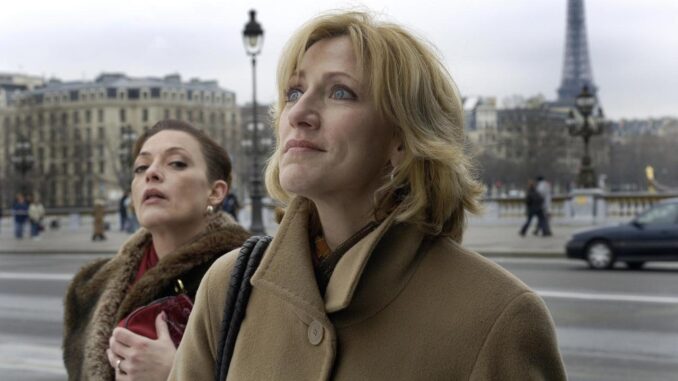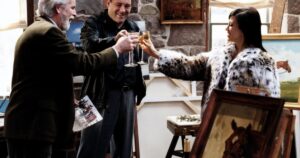
This year has been something of a victory lap for The Sopranos (1999–2007), the mold-breaking HBO drama following the life of New Jersey mob boss Tony Soprano, played by the late actor James Gandolfini. The 20th-anniversary celebration has seen countless pieces reassessing the show’s indelible impact on television and wider pop culture.
Critics and fans have extensively discussed the show’s use of anti-heros, psychology, and dreams. The Sopranos upended mafia tropes and critiqued American culture at the turn of the millennium. But, during my own re-watch of the entire series on HBO Now and HBO Go, I found a more surprising theme emerging—the integral role that visual art played in the show. It became abundantly clear that The Sopranos had a habit of using art as a means for characters to experience moments of epiphany, in a way that fundamentally progressed their character arcs.
The series “uses pieces of art to open this kind of psychological channel within the character that leads them to a new place that they wouldn’t have otherwise gone,” said Hannibal Deiz, who co-hosted the analysis podcast “The Sopranos Show,” with Gavin Bowen.

In the pilot episode, family patriarch Tony sits in the waiting room of his new psychiatrist, Dr. Melfi (played by Lorraine Bracco), following his first panic attack. As Tony waits, he stares at a sculpture of a naked woman. The camera cuts between the statue’s stony gaze and Tony’s perplexed face, his lips pursed in both confusion and fascination.
During their session, Tony says: “Lately I’m getting the feeling that I came in at the end. The best is over.” Dr. Melfi responds: “Many Americans, I think, feel that way.” Their meeting sets the tone for the entire series—the show is not just about mob violence, but about decay, family, and, perhaps more than anything, the influence of women in Tony’s life.
Each woman in Tony’s life represents a different archetype: his mother, Livia (Nancy Marchand); his wife, Carmela (Edie Falco); his daughter, Meadow (Jamie Lynn-Sigler); his multiple mistresses; and Dr. Melfi herself. Tony behaves differently around each of them. As TV critics Alan Sepinwall and Matthew Zoller Seitz write in their book The Sopranos Sessions (2019): “Tony alternates between courtly and protective, and peevish, possessive, and crude, depending on the woman.”
As Sepinwall and Seitz pointed out, the sculpture is shot to signify dominance and Tony’s mother. Livia is domineering and manipulative. Her influence weighs on Tony throughout the series. The statue, too, is a symbol of that power. As a work of art, it also serves as a reminder that there can be lasting beauty in a world that Tony sees as deteriorating, a world where the best is over.
In the episode “Denial, Anger, Acceptance,” Tony fixates on a painting of a red barn in Dr. Melfi’s office. He asks her if it’s a “trick painting” like a “core-shack test”—a mispronunciation of Rorschach test. But Dr. Melfi takes him seriously; she wants to know what the painting says to Tony. Tony replies: “It says, hey asshole, we’re from Harvard and what do you think of this spooky depressing barn and this rotted out tree we put here.” The painting provokes Tony and allows him an outlet for his feelings of inferiority: There are things in the world outside of his purview and above his understanding. Dr. Melfi sees a link between Tony’s morbid interpretation and his personal life. The tree isn’t rotting—Tony is projecting his feelings of sadness about the fact that his friend, and the boss of the New Jersey family, Jackie Aprile is slowly dying of cancer.
Later on, Tony becomes perplexed by another painting above his mistress’s bed, of a bright, colorful swimming pool and cabana. When Tony asks her what she sees in the painting, she says, nothing, that it just reminds her of David Hockey (a mispronunciation of David Hockney). Even if Tony doesn’t get the same insightful answer from his mistress that he does from Dr. Melfi, art provides a means to search for something deeper. “It’s these levels of detail that kind of separate The Sopranos from other TV shows,” Bowen said. “Where was the episode where Walter White was looking at a painting or statue that made him consider what he’s going through in Breaking Bad?”
The commissioning of an artwork in The Sopranos becomes a central plot point in a multi-season conflict and a crucial progression of Tony’s arc. In season four, Tony takes control of the racehorse Pie-O-My from his captain Ralph Cifaretto (Joe Pantoliano), with whom he has a longstanding grudge. In the episode “Mergers and Acquisitions,” Ralph introduces Tony to his new girlfriend, art dealer Valentina la Paz (Leslie Bega). Tony is intrigued by her beauty and contacts her to commission a painting of himself and Pie-O-My from an artist who specializes in horses. Tony excludes Ralph from the painting, bringing their feud closer to a boiling point.
The painting returns to the series at a pivotal moment. After the horse is killed at the end of season four in a fire started as part of Ralph and Tony’s escalating conflict, a distraught Tony orders for the painting to be burned. Instead, his crewmember Paulie Walnuts (Tony Sirico) ignores the order and has the painting retouched to show Tony as a Napoleonic general.
When Tony sees the painting in Paulie’s apartment in the fifth-season episode “All Due Respect,” he is furious, ripping it off the wall and throwing it in a dumpster. But then he pauses, regarding the image of him as a general: his sash, his hat, and the hilt of his saber. Tony realizes that his crew views him as a leader. In the next scene, Tony takes action: He shoots a close family member, bringing another season-long conflict to a bloody resolution.

Tony isn’t the only character to have significant encounters with artworks. Carmela, too, confronts inner conflict in the presence of art. In the season-three episode “Amour Fou,” she finds herself in front of Jusepe de Ribera’s painting The Holy Family with Saints Anne and Catherine of Alexandria (1648), while visiting the Metropolitan Museum of Art with Meadow. Carmela is feeling unwell—she worries she has either ovarian cancer or is pregnant. Throughout the season, she has grappled with leaving Tony but doesn’t want to lose her life or betray her Catholic faith. Carmela is struck by the painting’s tranquility, and she cries. “It upsets her because she knows that she is not innocent and she wishes that she was,” Deiz said. “She knows that she is tainted and corrupted by Tony’s business and so are her children—and that is really devastating for her.” Over the course of the episode, however, she ultimately decides to stay in her marriage.
Near the end of the series, in the episode “Cold Stones,” Carmela is awestruck by a famous work again, this time on a trip to Paris with her friend Rosalie Aprile. They go to leave the mundanity of their day-to-day lives, but Carmela still worries about things at home, mainly the disappearance of a close family friend whose murder has been kept from her at Tony’s command. On the Pont Alexandre III bridge, Carmela gazes at one of the statues adorning the arches. “Who could have built this?” she asks, astonished. Later, in the Thermes de Cluny, all of Paris’s art, culture, and history weigh on Carmela and she begins to cry. “We worry so much,” she says. “But in the end it just gets washed away.”
Carmela realizes how small her life is in the unceasing river of time, but that it’s a life she can’t escape. None of the characters can escape from the world of the mob, which leads only to death and misery. Works of art allow certain characters, for just a moment, to confront their grim reality, to see a way to maybe rise above it. Yet, in the end, no one can.
